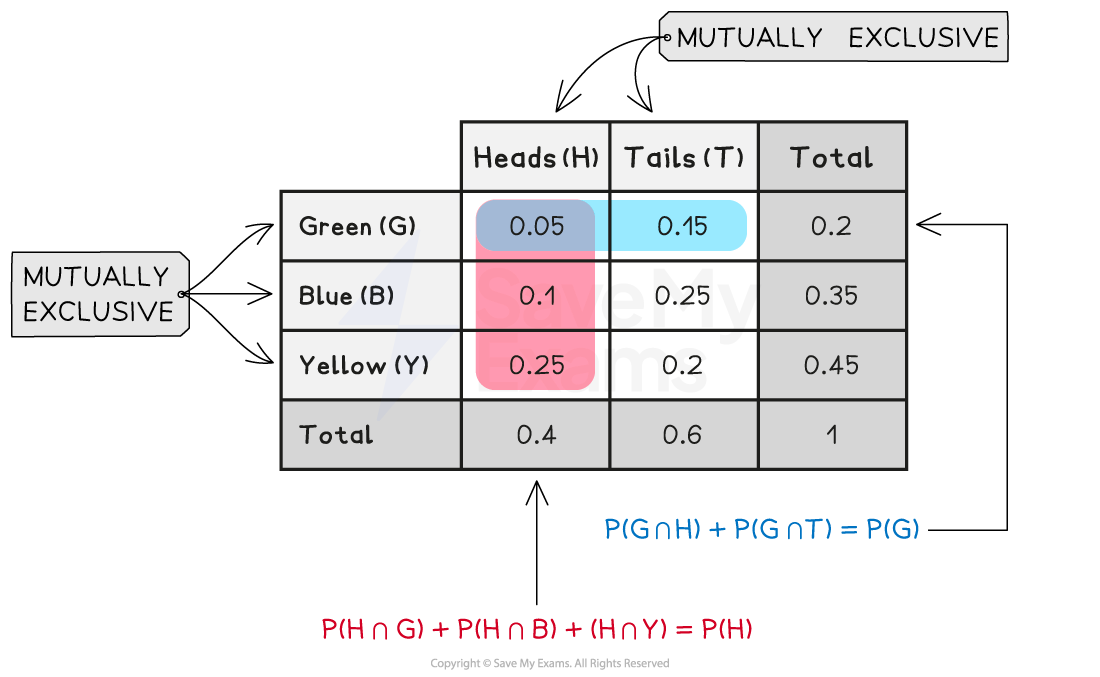Addition Rule & Mutually Exclusive Events (College Board AP® Statistics): Study Guide
Addition rule
What is the addition rule?
The addition rule is used to find the probability of the union of two events
To find the probability of
or
or both
Add together the probability of
and the probability of
Subtract the probability of
and
both occurring
This is because it has been counted twice (once for
and once for
)
This formula is given in the exam
The addition rule can be used to find the probability of the intersection of two events
Worked Example
The owner of a company buys each employee a sandwich for lunch every day. One day, there are two options: peanut butter and jelly sandwiches or grilled cheese sandwiches.
64% of the employees like peanut butter and jelly sandwiches.
72% of the employees like grilled cheese sandwiches.
5% of the employees do not like either of the options.
Find the probability that a randomly selected employee likes both of the options.
Answer:
Let be the event that the employee likes peanut butter and jelly sandwiches
Let be the event that the employee likes grilled cheese sandwiches
Identify the probabilities
64% like peanut butter and jelly sandwiches and 72% like grilled cheese sandwiches
5% of employees do not like either of the options
This means that 95% of employees like at least one of the options
Use the addition rule to find the probability that the employee likes both of the options
The probability that a randomly selected employee likes both of the options is 0.41
Mutually exclusive events
What are mutually exclusive events?
Mutually exclusive events are events that contain no common outcomes
The events cannot happen at the same time
e.g. landing on a 5 and landing on an even number on the same dice roll are mutually exclusive events
e.g. landing on a 5 and landing on an odd number on the same dice roll are not mutually exclusive events
Mutually exclusive events are also called disjoint events
Any event and its complement are mutually exclusive

How can I check whether two events are mutually exclusive?
If
and
are mutually exclusive events then
The addition rule for mutually exclusive events simplifies to
This can be extended to more than two events
e.g. if
,
and
are mutually exclusive events then
Too check whether
and
are mutually exclusive, check if one of the following equivalent statements is true:
How can I find probabilities involving mutually exclusive events?
If
and
are mutually exclusive events then for any event
This is called the partition theorem
This formula is useful in exam questions especially when using a tree diagram or two-way tables
e.g. the probability of picking a green marble is equal to:
the probability of picking a green marble and a coin landing on heads
plus the probability of picking a green marble and a coin landing on tails

Worked Example
In a high school, 15% of all the students wear glasses and 25% of all the students can write with their left hand. 35% of all the students wear glasses or can write with their left hand or both. A student is selected at random.
(a) Determine whether the events "the student wears glasses" and "the student can write with their left hand" are mutually exclusive. Explain your answer.
Answer:
Let be the event that the student wears glasses
Let be the event that the student can write with their left hand
Identify the probabilities
The 35% of students who wear glasses or can write with their left hand includes the students (if any) who wear glasses and can write with their left hand
If they are mutually exclusive then
Check to see if this formula works for these events
The events "the student wears glasses" and "the student can write with their left hand" are not mutually exclusive because
(b) Find the probability that the student wears glasses and cannot write with their left hand.
Answer:
The probability that is needed is
Use the addition rule to find the probability that the student wears glasses and can write with their left hand
A student can either write with their left hand or they cannot write with their left hand
Therefore the events and
are mutually exclusive so use the partition theorem
The probability that a student wears glasses and cannot write with their left hand is 0.1

Unlock more, it's free!
Did this page help you?